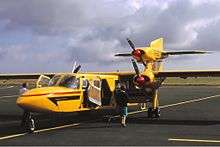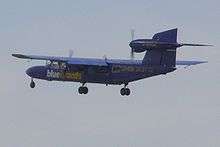Britten-Norman Trislander
The Britten-Norman Trislander (more formally designated the BN-2A Mk III Trislander) is an 18-seat three-engined piston-powered civilian utility aircraft produced in the 1970s and early 1980s by Britten-Norman of Britain. These STOL capable aircraft were produced on the Isle of Wight. They were also produced in Romania, and delivered via Belgium to Britain for their certification.[1] A number of commuter airlines operated the Trislander in scheduled passenger services.
| Trislander | |
|---|---|
.jpg) | |
| Aurigny Air Services Trislander | |
| Role | Airliner |
| Manufacturer | Britten-Norman |
| First flight | 11 September 1970 |
| Status | Out of production, in service |
| Primary user | Vieques Air Link Roraima Airways |
| Produced | 1970–1980 |
| Number built | 72 |
| Developed from | Britten-Norman Islander |
Design and development
Designed by John Britten and Desmond Norman, the Trislander is a further development of Britten-Norman's better-known Islander aircraft in order to give it a larger carrying capacity. In comparison with the Islander, the Trislander has a stretched fuselage, strengthened, fixed tricycle landing gear and a third engine on the fuselage centre line atop the fin. The Trislander has exceptional low speed handling characteristics, extended endurance, increased payload, low noise signature and economical operating costs. Capable of taking off from a 492-yard long landing strip, the Trislander can readily operate from unprepared surfaces.
Operational history
The prototype of the Trislander, which was constructed from the original second Islander prototype, first flew on 11 September 1970.[2] The type entered service with the Guernsey-based Aurigny in July 1971.[3] Initial production ceased in 1982 after 73 had been sold and delivered, with a further seven Trislanders unsold, when Pilatus Britten Norman sold a manufacturing license to the International Aviation Corporation (IAC) of Florida. It was planned for IAC to build 12 Trislanders (to be known as Tri-Commutairs) from parts kits supplied by Britten-Norman before undertaking full production,[4] but these plans came to nothing.[5]
Variants
- BN-2A Mk III-1
- First production version, with short nose.
- BN-2A Mk III-2
- Lengthened nose and higher operating weight.
- BN-2A Mk III-3
- Variant certified for operation in the United States.
- BN-2A Mk III-4
- III-2 fitted with 350 lb rocket-assisted takeoff equipment.
- BN-2A Mk III-5
- III-2 with sound-proofed cabin, modernised cockpit/interior and new engines (proposed, unbuilt as yet).
- Trislander M
- Proposed military version, not built.
Former operators



- Aerodata
- Air Queensland
- Lucaya Air
- Burrard Air Ltd.
- Questor Surveys Ltd.
- Tavina
- Travel Air
- Air Pacific
- Aurigny[9] At its peak, Aurigny operated 16 Trislanders, the largest operator of the type.[3] As of 2018 all Trislander aircraft have been retired from service.[10][11] One of the Aurigny Trislander aircraft is on static display at the Imperial War Museum Duxford in the UK and one of them is displayed at Oaty & Joey's play barn at Oatlands in Guernsey.[12]
- Taiwan Airways
- Turks & Caicos Airways
- Air Ecosse
- Air Sarnia
- Emerald Airways
- Lydd Air[15]
- Loganair[16]
- National Airways
- Rockhopper Aero
- Sky Trek
- Willow Air
- XP - Express Parcel Systems
- Air Flamenco
- Air St. Thomas
- Air South
- Cen-Tex Airlines
- Channel Islands Aviation (based at the Oxnard Airport)
- Slocum Airlines
- Stol Air Commuter (renamed WestAir Commuter Airlines)
- Tri Air
- Wings Airways
- Vanair
- Unity-Airlines
- Chapi Air
- Sol America
Accidents and incidents
On 15 December 2008, a Trislander operated by LAP in Puerto Rico, the first crash since 2005. The aircraft crashed into the sea somewhere near the Turks and Caicos, shortly after a distress call. A spokesman for the Asociación Nacional de Pilotos reported that the pilot had his licence suspended in October 2006.[17]
On 5 July 2009 in New Zealand, a Trislander belonging to Great Barrier Airlines lost its starboard side prop six minutes into a flight from Great Barrier Island to Auckland city. The prop sheared off and impacted the fuselage, prompting a successful emergency landing. While there were injuries, no deaths were reported. The accident was caused by undetected corrosion of the propeller flange which led to its eventual failure.[18]
On 8 October 1977 ZS-JYF, operated by Southern Aviation, impacted the ground while attempting a stall turn during an air display at Lanseria in South Africa. Despite sustaining severe damage (it was damaged beyond repair) the aircraft performed an emergency landing and neither occupant was injured. https://aviation-safety.net/database/record.php?id=19771008-1
Specifications (BN-2A Mk III-2)
.jpg)
Data from Jane's All The World's Aircraft 1976–77[2]
General characteristics
- Crew: 1 or 2
- Capacity: 16 or 17 passengers
- Length: 49 ft 3 in (15.01 m)
- Wingspan: 53 ft 0 in (16.15 m)
- Height: 14 ft 2 in (4.32 m)
- Wing area: 337.0 sq ft (31.31 m2)
- Aspect ratio: 7.95:1
- Airfoil: NACA 23012
- Empty weight: 5,842 lb (2,650 kg)
- Max takeoff weight: 10,000 lb (4,536 kg)
- Fuel capacity: 154 imp gal (185 US gal; 700 L)
- Powerplant: 3 × Lycoming O-540-E4C5 air-cooled flat-six piston engines, 260 hp (190 kW) each
- Propellers: 2-bladed Hartzell HC-C2YK-2G/C8477-4 constant speed propellers
Performance
- Maximum speed: 180 mph (290 km/h, 160 kn) at sea level
- Cruise speed: 155 mph (249 km/h, 135 kn) (59% power) at 13,000 ft (4,000 m)
- Range: 1,000 mi (1,600 km, 870 nmi)
- Service ceiling: 13,160 ft (4,010 m)
- Rate of climb: 980 ft/min (5.0 m/s)
- Take off run to 50 ft (15 m): 1,950 feet (590 m)
- Landing run from 50 ft (15 m): 1,445 ft (440 m)
See also
Related development
- Britten-Norman Islander
Aircraft of comparable role, configuration and era
References
- Historians, BN. "Home – BN Historians Website 2014".
- Taylor, John W. R. Jane's All The World's Aircraft 1976–77. London: Jane's Yearbooks, 1976. ISBN 0-354-00538-3, pp. 176-177.
- Cunliffe, Charles. "Trislander Sunset". Air International. October 2015, Vol. 89, No. 4. ISSN 0306-5634, p. 123.
- Taylor, John W. R. Jane's All The World's Aircraft 1982–83. London: Jane's Yearbooks, 1982. ISBN 0-7106-0748-2, pp. 268, 392.
- Trevett, John. "Commuter Aircraft Directory: International Aviation Corp (USA)". Flight International, 11 May 1985, p. 47.
- https://www.ch-aviation.com/portal/news/78194-anguilla-air-services-adds-maiden-trislander
- "Roraima unveils Britten Norman Trislander". 26 April 2016.
- "The Official Web site of Liat The Caribbean Airline – Liat Airline".
- "aurigny.com – channel islands". Archived from the original on 13 September 2008. Retrieved 1 December 2015.
- "Aurigny Trislander takes final commercial flight".
- "Trislander for Solent Sky". Aeroplane. Vol. 45 no. 5. May 2017. p. 10. ISSN 0143-7240.
- https://www.iwm.org.uk/visits/iwm-duxford
- "Aircraft fleet, Blue Islands aircraft fleet, Blue Islands ATR aircraft - Blue Islands". www.blueislands.com.
- "Barrier Air. Fleet".
- "Our fleet".
- "Loganair :: Aircraft – Loganair". Archived from the original on 8 December 2015. Retrieved 3 December 2015.
- "Accident description". Aviation Safety Network, Flight Safety Foundation, 16 December 2008. Retrieved: 28 February 2009.
- "Investigation 09-004 Report 09-004, Britten Norman BN2A-Mk III Trislander, ZK-LOU loss of engine propeller assembly, near Claris, Great Barrier Island, 5 July 2009." Archived 3 October 2011 at the Wayback Machine New Zealand Transport Accident Investigation Commission (TAIC) via taic.org. Retrieved: 11 May 2011.
Further reading
| Wikimedia Commons has media related to: |
- US 3807665, published 1974-04-30, assigned to Britten Norman
- The Illustrated Encyclopedia of Aircraft (Part Work 1982–1985). London: Orbis Publishing, 1985.
- Stroud, John. "Post War Propliners: Islander and Trislander". Aeroplane Monthly. Vol. 22, No. 8. August 1994. pp. 44–49. ISSN 0143-7240.
- "Britten-Norman BN-2A Mk.3 Trislander". airliners.net.
- Britten-Norman company